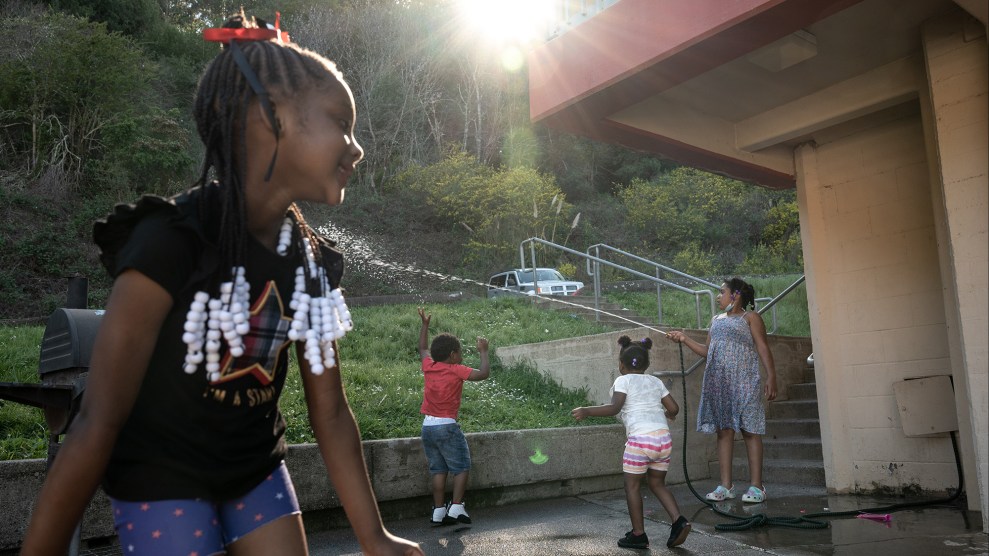
Mother Jones illustration; Getty
In the fables of environmentalism, lawyers are heroes. They invented the legal theories and mustered the facts to stop countless dams, mines, timber sales, and other harmful projects.
But somewhere along the line, environmentalists stopped treating litigation as a tool and started behaving as if it’s an end in itself—an end to be preserved even at a steep cost to the environment. That’s the lesson of recent legislative sessions in California, culminating in the blockbuster housing bills of 2023.
If you ask any environmentalist about housing, they’ll tell you that states like California need to allow a lot more of it in urban areas, especially near transit, and to put the brakes on exurban sprawl, especially in environmentally sensitive areas. This mantra dates to the 1990s, when the Sierra Club labeled sprawl “the dark side of the American Dream” and the Natural Resources Defense Council teamed up with the American Planning Association to forge a “smart growth alliance.”
You might suppose, then, that groups like the Sierra Club and NRDC would enthusiastically support bills that pressure cities to approve denser “infill” housing, and that they’d fight like mad against bills that grease the wheels for sprawl. You would be wrong.
This year, the California legislature passed two hugely important infill housing bills—over fierce opposition from dozens of environmental groups. State Sen. Scott Wiener’s SB 423 requires cities that aren’t making enough progress toward their state-mandated housing targets to approve certain infill projects “as of right.” This means that the city can’t make design changes or impose ad-hoc fees and other demands if the project meets applicable, objective standards.
A complementary bill—AB 1633, introduced by Assemblymember Phil Ting—prevents cities from using a California Environmental Quality Act review as a pretext to stall infill housing, a problem I’ve previously written about for Mother Jones.
Environmental groups said these measures would rip the heart out of CEQA, even though the bills only apply to infill projects in cities—not on farmland or in the wilds. The greens also exploded in fury when Gov. Gavin Newsom proposed minor changes to CEQA litigation procedures last May, changes a top NRDC lawyer acknowledged were inconsequential and would likely be ignored by the courts. (NRDC still lined up against it.)
As the environmentalists waged their battle against infill housing and symbolic CEQA tweaks, the Legislature was tinkering with another, hugely powerful statute called the Density Bonus Law, first enacted in 1979. It says that if the developer a project sets aside a share of the units for affordable housing, the developer can make the project a little bigger than the local government would otherwise allow. For example, if a city code allows up 40 dwellings on a site, and the bonus is 25 percent, the owner of the site could build up to 50 units.
This past August, the Legislature enacted statewide “unzoning” by making a little-noticed change to those calculations. Bear with me now—if your eyes are glazing over, you can bet legislators’ eyes were glassy too. But the details really matter!
Local density limits are found not only in municipal zoning codes, but also in a city’s “general plan.” In keeping with the name, general plans are vaguer and less specific than zoning codes. Back in the 1970s, California courts started ruling in favor of NIMBYs who argued that a city could not approve projects if zoning codes were inconsistent with the general plan. This incentivized cities and counties to make their general plans even more general, so city elders could approve—or deny—pretty much anything.
But the Legislature has now decided that if the total number of units in a density-bonus project is allowed by the general plan, the project can go forward regardless of whether the site’s zoning is much more restrictive, as it usually is. The upshot is that general plans, adopted decades ago to maximize the discretion of local officials, will now have exact the opposite effect, compelling city councils and county commissions to approve housing they never actually planned for.
What’s also amazing is that the revisions to the Density Bonus Law require local governments to waive virtually any development standard that would prevent the project from going forward as designed. Unless the city or county can show that a standard is necessary for public health or safety—a circumstance the Legislature has deemed “rare”—the standard is toast.
If you believe we need to build more housing, this sounds great. But there’s a catch, too. The way the Legislature wrote the law, it doesn’t matter where a project is located. In far-flung exurbs, on ecologically sensitive lands, in the wildland-urban interface—literally anywhere—local development restrictions have vanished for any developer who sets aside 5 percent of their units for very-low-income households. Don’t be deceived by the name, either: Nothing in the Density Bonus Law requires that a density-bonus project actually be dense. The developer can build at any density up to the general-plan maximum, plus the state bonus.
In some cases, the new Density Bonus Law will in fact be great, yielding lots of dense housing in places that desperately need it, like Los Angeles. In other cases, it may be awful, generating large-lot exurban subdivisions in places better suited for managed retreat. The pattern will be helter-skelter because lawmakers chose to piggyback on local general plans, rather than decide for themselves where denser housing should be allowed. By contrast, with the infill housing bills (SB 423 and AB 1633), the Legislature made careful decisions about what places and parcel types are best suited for housing and thus warrant a quick approval process.
But the really stunning thing about the changes to the Density Bonus Law is that they didn’t trigger a peep of opposition from environmental groups—which were busy catastrophizing about the carefully targeted infill housing bills.
Were greens groups comforted by the fact that the density bonus modifications don’t touch CEQA? Maybe, but even if a proposed density-bonus project is shown to have serious environmental impacts, the city or county is now powerless to deny it. Why? Because of bill passed two years ago that literally crossed out the environmental exception. Here, too, environmental groups were asleep at the wheel: not a single group registered opposition.
Maybe the Big Greens and their lobbyists just don’t understand the intricacies of housing law. I get it, it’s complex. But California’s legislature has been hard at work on housing since 2017. The California Building Industry Association (which represents “greenfield” or sprawl-prone developers) and pro-housing litigation shops have been pushing their “if the general plan allows it, you must approve it” idea through bills and court cases since 2018.
The upshot is the green groups seem to be saying, “I care about CEQA, but not about housing or the environment.”
What in the world is going on? The simple explanation is that lawyers have way too much heft within environmental organizations. They’re the heroes, after all. They generate headlines and bring in lots of revenue, courtesy of rules that require public agencies that lose a lawsuit to pay the victorious nonprofit’s legal fees. CEQA, a statute of fathomless complexity, is just terrific for environmental attorneys, even if it’s not always so great for the environment.
I participated in the 11th-hour negotiations over Ting’s infill housing bill, AB 1633*. In one meeting, a senior lawyer for a premier environmental group said that in his opinion, “CEQA shouldn’t apply to housing inside city limits, period.” Yet the group was wavering. Not on whether to endorse the bill—which no environmental group did—but on whether to formally oppose it. The group wounded up doing just that, sending Ting an email explained that they had “heard more…from community-based partners” who were concerned the bill could “apply to more than cases brought under the Housing Accountability Act.”
That opaque statement alluded to a provision of the bill that encourages courts not to award attorneys’ fees to plaintiffs who challenge a good infill project, unless its approval was in bad faith. This will probably dissuade some local groups from suing cities that reasonably approved a housing project. Or from using the threat of CEQA litigation to extract perks from developers for neighborhood interests or labor. But if you care about environmental outcomes, this is all to the good: California needs to make it cheap and easy to build infill housing, and all those perks drive up the cost.
The email’s reference to “community partners” is also telling. Groups with community in their name are often environmental justice organizations. The environmental movement was historically white and upper-class, focused on wilderness preservation. Its leaders were slow to realize that poor communities of color suffer from concentrated hotspots of pollution. This history makes it tricky for older greens to criticize EJ groups for taking positions or filing lawsuits that serve hyper-local interests while undermining state and global climate goals. But a housing development does not remotely have the environmental toll of an oil refinery, power plant, or interstate highway, and no one suffers more from the lack of housing than poor people.
It’s not a coincidence that the pell-mell unzoning sought by greenfield developers was finally achieved through a law that awards bonuses for low-income housing. To oppose the changes to the Density Bonus Law might have felt, well, a little bit racist.
But if environmental groups are going to achieve environmental objectives, they need to check their lawyers and balance feelings with clear thinking. Mitigating and adapting to climate change will require loads of new infrastructure. Housing is just the tip of it. Green infrastructure is already facing stiff resistance from local communities. Environmental law needs to do a much better job reckoning with which community objections to take seriously, and how to address them. The alternative is a geographically arbitrary sclerosis in which very little gets built where lawyers and lobbyists are powerful, while projects slip through elsewhere. That’s not a great strategy for keeping natural areas intact, and it’s disastrous for projects like high-voltage transmission lines or rail, which require linking disparate geographies along well-planned routes. Empowering any NIMBY to hold up projects with a lawsuit is a recipe for $100 billion trains to, and from, nowhere, as Californians have ruefully learned.
I don’t know what it will take to reorient the Big Green groups. But I hope the foundations and philanthropists who underwrite them will start asking some pointed questions.
*Elmendorf is the Martin Luther King, Jr. Professor of Law at the University of California-Davis. He provided pro-bono advice to Assemblymember Phil Ting and the sponsors of AB 1633, including San Francisco Planning and Research (SPUR), California Yimby, and the Bay Area Council.











